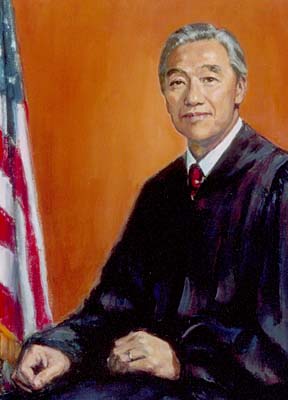
COURTESY PHOTO
An oil painting of Judge Herbert Y.C. Choy by renowned artist Anne Mackintosh will be displayed at the headquarters of the 9th U.S. Circuit Court of Appeals in San Francisco.
Several former law clerks of Judge Herbert Choy said the first Korean-American lawyer and the first Asian federal judge in the United States personified fairness and integrity. Judge Herbert Choy
being honored todayHis former law clerks praise
the first Asian U.S. federal judgeBy Pat Gee
pgee@starbulletin.comJudge Richard Clifton, who succeeded Choy on the 9th U.S. Circuit Court of Appeals last year, said Choy would make sure something that would help an applicant's case was not buried in a brief.
Clifton said Choy was "very meticulous" and "spent enormous hours" reading legal documents because he felt "it was important to do the job properly."
Choy is being honored with the dedication of a portrait, commissioned by his former law clerks, at a U.S. District Court Conference luncheon today at the Halekulani Hotel.
He is semiretired with "senior" status since 1984.
Now 87 years old, Choy still work on cases that do not require hearings and travel, Clifton said.
His first law clerk, John McGuckin, general counsel of the Union Bank of California in San Francisco, spearheaded the idea for Choy's 70-plus former law clerks to commission a portrait of Choy in keeping with a federal court tradition.
The oil painting, by renowned artist Anne Mackintosh, will be displayed at the San Francisco federal court headquarters.
McGuckin said, "I am the oldest of his 31 generations of children. He always called us his official family, and that's a major part of the way we feel about him."
Clifton, one of his first law clerks from 1975 to 1976, said he felt Choy was "especially careful" in dealing with immigration appeal cases because he could identify with the "immigration experience." (Nearly half of the immigration cases in the country came before the 9th Circuit then, and still do.)
Born on Kauai, Choy was the son of one of the thousands of Koreans who came to work on Hawaii's sugar plantations and are celebrating the centennial landmark this year, Clifton said.
McGuckin said he remembers the appeals court also dealt with a lot of criminal appeals, including drug and draft evasion cases, which the law clerks would research, preparing a "bench memo" for the judge.
"I remember several times the judge returning the memo to one of us, saying, 'That's a pretty good legal analysis, but I don't think it's fair. Let's look at the case again,'" McGuckin said.
"He taught us all that we should consider it an honor to be a lawyer, and wanted us to practice our profession the same way he had," he added.
Craig Nakamura, an assistant U.S. attorney who was "privileged" to clerk for Choy from 1981 to 1982, said the judge was "one of the most powerful role models to me as an Asian American. He showed me it was possible for an Asian American to achieve such a high level."
"He made sure every appeal received justice, and was a living example that you could be very effective on the strength of reasoning, logic and the use of law, not through theatrics or personal attacks," Nakamura said.
Girard Lau, a deputy with the state attorney general's office, said Choy was "extremely fair-minded and would not prejudge a case." His temperament was "always calm, very professional," and he is "genuinely a very nice man, a pleasure to work with. He would not intimidate you even though he was brilliant," said Lau, who clerked for Choy from 1984 to 1985.
